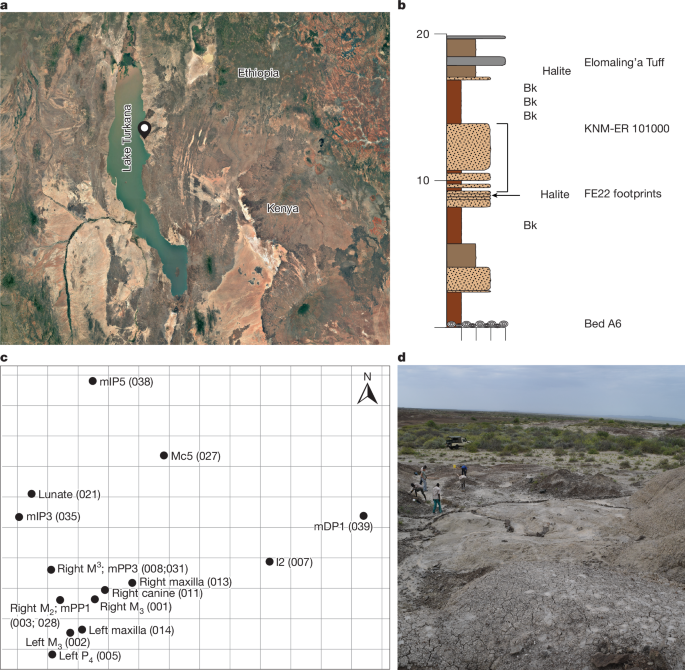New fossils reveal the hand of Paranthropus boisei
Article Date: 15 October 2025
Article URL: https://www.nature.com/articles/s41586-025-09594-8
Article Image: Figure 1
Summary
Researchers report a partial skeleton (KNM-ER 101000) from Koobi Fora, Kenya — dated to about 1.52 million years ago — that preserves craniodental material securely attributable to Paranthropus boisei together with associated hand and foot bones. The dentition and cranial fragments match classic P. boisei traits (large postcanines, hyperthick enamel, sagittal crest). The hand shows modern-like thumb proportions but retains ape-like wrist and basal-thumb features; the digits and hypothenar region are exceptionally robust and converge, in some respects, on gorilla morphology. The foot indicates a committed bipedal mechanics with a transverse arch but a slightly shorter hallux than modern humans. Overall, the anatomy implies strong grasping ability and potential for tool-related behaviours, while also supporting divergent dietary and ecological specialisations between Paranthropus and early Homo.
Key Points
- KNM-ER 101000 is a ~1.52 Ma partial skeleton from Koobi Fora with craniodental, manual and pedal elements associated unambiguously with Paranthropus boisei.
- The teeth and cranial fragments (including a sagittal crest) strongly support attribution to P. boisei.
- Hand proportions show a long thumb relative to the fingers (human-like), enabling precision grips, but wrist and trapezium morphology are more primitive (ape-like).
- Thumb, hypothenar region and phalanges are very robust — convergent in parts with Gorilla beringei — consistent with powerful grasping and forceful manual processing of tough plant foods.
- Foot anatomy indicates a stiff transverse arch and dorsiflexion-adapted hallux consistent with efficient bipedal push-off, though the hallux is shorter than in modern humans.
- Findings imply P. boisei had the capability for tool use and manufacture in some capacity, but its manual mechanics likely differed from later Homo specialised for precision pinches.
- Reconstructing the Homo–Paranthropus last common ancestor suggests an ancestral hand adapted for strong, stabilised power grips; the derived precision wrist of Homo evolved later.
Content summary
The KNM-ER 101000 fossils were recovered from lake-margin sediments at Koobi Fora and dated relative to local stratigraphy to slightly older than 1.52 Ma. Dental metrics (crown sizes, enamel thickness) and cranial fragments (including a sagittal crest and zygomatic/maxillary features) place the specimen within P. boisei.
Associated manual elements — thumbs, metacarpals, phalanges and wrist bones — reveal a mix of derived and primitive traits: pollical and digital proportions that permit human-like pad opposition and potential precision grips, but an overall carpal configuration more similar to African apes. The thumb and ulnar side of the hand are particularly robust, with pronounced muscle attachment areas. Intermediate and proximal phalanges are massively built, suggesting strong flexor musculature and forceful gripping capacity.
Pedal remains (hallucal proximal phalanx and third metatarsal) indicate a foot with a well-developed transverse arch and adaptations for stiff push-off in bipedal locomotion, but a relatively shorter hallux than Homo sapiens, pointing to subtle differences in push-off mechanics.
Taken together, KNM-ER 101000 implies P. boisei combined bipedal terrestriality with powerful manual abilities that could support tool use and intensive manual food processing — likely reflecting dietary specialisation rather than exclusive arboreal behaviour. The specimen also refines interpretations of older contested material (for example, OH 7 and OH 8) and informs ancestral reconstructions of hominin hand evolution.
Context and relevance
This is a high-impact find for palaeoanthropology because it provides the long-missing, securely associated hand and foot anatomy for P. boisei. It directly addresses longstanding debates about whether Paranthropus made or used tools and how hand evolution unfolded in early hominins. The mixture of human-like digit proportions with ape-like wrist architecture clarifies that strong gripping and some manipulative capability existed outside the Homo lineage, while specialised precision mechanics evolved later in Homo. It also supports models of ecological partitioning: Paranthropus as a dietary specialist relying on powerful manual processing, and Homo as a more behaviourally flexible tool-using generalist.
Author style
Punchy: this paper matters. It fills a major anatomical gap — hand and foot bones securely tied to P. boisei — and reshapes who could plausibly make and use early stone tools. If you follow human origins, the anatomical details here are worth digging into.
Why should I read this?
Want to know who might have been fiddling with the first stones and how our hands evolved? This one gives you the goods — a real Paranthropus hand and foot, not just hints. It changes the story: powerful grips and possible tool use outside early Homo, plus fresh clues about diet and locomotion. Short version: big deal for anyone curious about the roots of tool behaviour and hand evolution.

